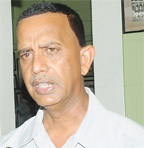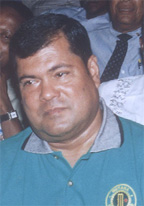By Troy Peters
Guyana’s cricket, once the admiration and envy of most of the regional territories for its astute leadership and sound developmental programmes because of its domination of regional cricket especially at the U19 level over the past years now finds itself reeling towards a stage of destruction never experienced before.

A few years ago it was even suggested that a Guyana selection could have represented the West Indies because of the calibre of players that were produced locally.
The Berbice and Demerara Cricket Boards were turning out junior players by the dozens and the chemistry of Albert Smith and Carl Moore both Berbicians as national coach and manager respectively were an unstoppable combination.
Guyana has won the regional U19 cricket competition on 12 occasions beginning with the inaugural 1968 tournament.
Andre Percival then led Guyana to a hattrick of title wins in 1992, 1993 and 1994 while Mahendra Nagamootoo continued the trend in 1995 after original captain Nicholas De Groot was injured.
But it was in 2000 that the Guyanese won seven consecutive titles under Narsingh Deonarine, Troy Cornelius (2001), Sauid Drepaul (2002), Assad Fudadin (2003), Zamal Khan (2004), Leon Johnson (2005)and Steven Jacobs (2006 and 2007).
The players who were budding at the junior level over the period mentioned earlier should have been the ones to take Guyana cricket now to a new high but instead there has been a downward trend.
Its even hard to believe that only three years ago Guyana won the inaugural Stanford Twenty20 series and lost to Trinidad and Tobago in the second competition.
What has gone wrong in Guyana’s cricket over the past two years needs careful analyzing.
We have seen Guyana plunge from a giant in West Indies cricket now to the region’s cricket minnows.

We can safely say that the nation’s cricket is at its lowest ebb and those who would have made sacrifices over the years should be surely saddened at the state of affairs and may be asking what may have gone wrong.
These problems did not emerge overnight, but recent events have contributed significantly in triggering the rapid downward spiral.
There were plans earlier this year to remove President of the Guyana Cricket Board (GCB) Chetram Singh who has been at the helm of local cricket for close to two decades.
The move by long time GCB Secretary and veteran cricket administrator Bishwa Panday to run against Singh for the top post at this year’s Annual General Meeting of the Board sparked a string of events that has left cricket administration on a wobbly footing while administrators are now suspicious of each other since the ballot.
Panday was defeated in a closely fought contest but some administrators who had chart the course of local cricket over the years including Panday are now sidelined, a few through their own volition while others were removed strategically .
We saw the departure of Alvin Johnson, immediate past president of the Essequibo Cricket Board and former vice- president of the GCB who had ambitions of running for the Board’s top job earlier this year, as well as Malcolm Peters who headed the Berbice Cricket Board prior to January when he was defeated in what could be regarded as a strategic move to unseat Singh by factions within his organization.
In light of Guyana’s poor showing, captain Travis Dowlin was sacked for his country’s final match in the 2009 regional tournament and racial allegations about the former skipper against a member of his team has surfaced which has been denied both by Dowlin and the player in question.
Before Dowlin’s sacking the national senior coach Smith was also axed after Guyana’s early dismal showing the 2009 regional season.
The composition of the selection panel is another contentious issue as well as the appointment of former national player Rabindranath Seeram as interim coach following the sacking of Smith.
Seeram did very little to turn around the team’s fortune and the result was an ignominious bottom-of-the-table placing with 33 points, 27 points behind the second of the bottom placed teams Barbados and Combined Colleges.
Even the GCB Development Officer, former West Indies fast bowler Colin Stuart offered his resignation citing difficulties to function in his position.
These are serious undercurrents at every level that are undermining the future of Guyana’s cricket development but is might very well be orchestrated by a few for their own nefarious scheme. There have been questions about some of the administrators and their commitment to the game or whether they are there to serve their own best interest.
Are there genuine attempts to undermine Singh administration and to bring down the Board outside of the democratic norms?
Most of the cricket that should be played on the field now are conducted in the boardrooms because of differences at the administrative level in almost all of the area boards some of these problems have even reached to the courts as in cases of East Bank Demerara and West Demerara over who should run the affairs of cricket in those areas.
In all this, there has been a dramatic decline in spectator support for both local and regional matches.
Imagine Guyana hosted several matches of the West Indies regional four-day series and there was just a sprinkle of support for the local team at all of the matches, a far cry from previous years, while the fan base for the West Indies/England two one day internationals was overwhelming. It clearly shows that Guyanese still love their cricket but the passion to support a team that has not delivered in recent times is evident.
Guyana’s cricket could ill-afford the current internal wrangling and dramatic slide after all the hard work that has gone into it development over the years.
Guyana is a proud cricketing nation and administrators must be prepared to iron out their differences to salvage national pride especially now this country in one of the venues earmarked to host matches in next year’s Twenty20 World Cup championships and another dismal season in 2010 could destroy our pride and joy.
